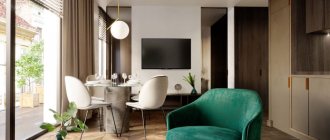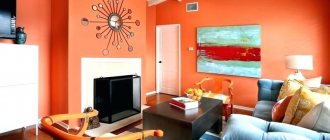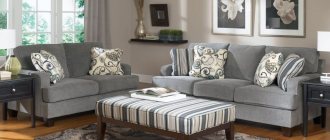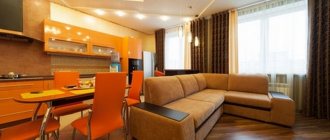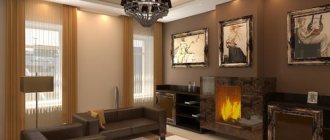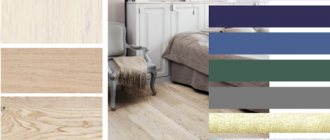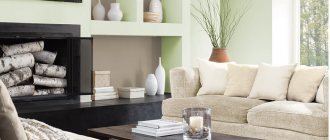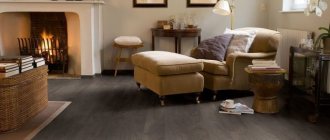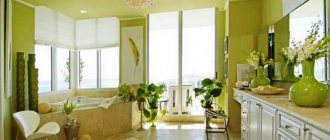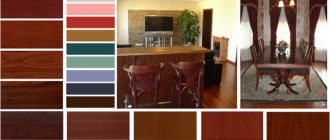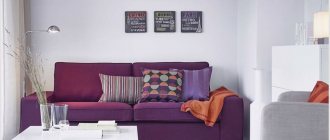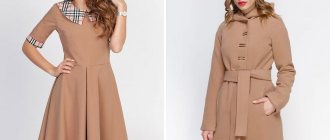Interior styles
Purple, in its variety of shades, attracts attention and fills the space with life. To create a harmonious interior in purple colors, you need not only to choose the right shade, but also to calculate its quantity and decide on the combination. In this article we have collected several recommendations for those who have decided to add a mysterious and mystical color to their home.
Features of purple color
Purple combines red and blue. From the first he takes warmth and brightness, from the second - depth and calm. Depending on the shade, it can be colder or warmer, active or background. Thanks to its diversity, the colors are appropriate in most styles: from relaxed classics to dynamic modern trends (high-tech, loft, minimalism).
In nature, such a palette is not often found, so it always looks unusual and attracts attention. Color psychology describes it as sensitive, romantic and even associated with magic. Because of this, it is necessary to select the range with caution - the one chosen thoughtlessly can turn the house into the home of a fortune teller or the decoration of a magical castle.
Where to use
Purple color looks good in any room. But when using colors of this range, you need to be careful not only in choosing the color, but even the shade. How light or bright it will be.
Texture, texture, shade - everything is important
The shades of all other colors in the interior are just as important. The slightest discrepancy introduces dissonance and “scratches” the eye. Textures are also important. Matte, velvet, glossy, pearl. All these nuances significantly change the perception of any shade of this range. Therefore, it is necessary to select all other colors/textures/shades. That is why designers do not like to tinker with this range - they are too demanding. A lot of time is spent on selecting little things.
In the bathroom
In the bathroom, purple prevents the formation of a “sterile” interior. Even if the room is tiled from floor to ceiling with a glossy surface. Warm shades do not give warmth and comfort and you want to be in such a room.
Purple, red and pale lilac. With mostly white and beige
Bathroom in lilac color - floral patterns are always in trend A little gloomy, but young people will like it
Different shades, different moods
Ideas for a stylish bathroom in lilac color
The combinations are described above: the main colors are white, beige, light shades of the same range, light gray. Accents can be placed using red or small black fragments, other bright or not very compatible colors. If you want more glamor and pomp, you can add gold and copper. Metallized parts will add more technocratism.
In the kitchen
Another technical room in our apartments and houses is the kitchen. Purple color is not very common in kitchen interiors, although it looks modern and relevant. When using glossy facades and rich colors, this can be a high-tech style or a modern style close to it. Accents in this case are placed either in black or metallic.
Soft lilac shades in matte facades are appropriate in Provence and classics. Here are the classic combinations: with white, yellow, olive. In such interiors you can often see floral patterns and prints. They give the kitchen a cozy feel.
Delicate lilac and white create a very cozy atmosphere in the kitchen
In combination with yellow it turns out very sunny and joyful
Two fairly bright shades are balanced by a wooden floor and a light beige warm shade of the walls
Glossy facades look stylish
Purple and lilac with a black and white kitchen apron
And here the silky texture greatly changes the perception
For a bright mood Stylized flowers in a lilac kitchen - to create a softer interior Photos are still too heavy
Many pure and beautiful shades of purple
Beige and “metallic” complement perfectly
With black or dark gray it turns out a bit gloomy...
You can use lilac and purple in the kitchen when decorating a backsplash or accent wall. It looks great with panels with plant motifs. The photos load up the kitchen space too much, and the stylized flowers look very stylish.
Shades
Thanks to the versatility of purple, people with different preferences can choose the shade they like. The most common are lilac, lilac, lavender, purple, eggplant, plum. Each of them helps to create its own atmosphere. It can be either notes of romance and tranquility, or luxury and nobility.
Dark purple colors are less common in the interior. The reason is that they are considered heavy and overloaded. Thanks to this, they can be used instead of black and other dark colors.
Combination of purple and yellow colors in the interior: ideas, photos
Another “natural”, natural and harmonious combination of colors that can often be found in nature and which does not cause negative emotions is purple and yellow. These colors look great together, but only when yellow is dominant and purple complements it.
However, rich yellow should also not be “overused” when creating interior design. It is best to give preference to pastel shades or dilute them with neutral and “calm” tones, such as brown, beige, gray.
Adviсe:
- The design of purple and yellow must be present in a bright and sun-filled room, otherwise it “risks” simply not being revealed in all its glory and becoming overly depressing, dark, and uninteresting.
- It is best to use weak shades of colors rather than bright “pure” colors to make combinations, in order to be sure that they will “take root” and will not cause negative emotions.
- These colors are perfect for decorating children's rooms, kitchens and living rooms. Bedrooms should use bed and light colors.
- In a yellow room, purple can be an excellent way to delimit the space into zones. To do this, you can paint one wall (for example, in the place where the sofa or TV is located) or the carpet on the floor.
- Remember that both colors can be called “bold”, which means that so that you don’t quickly get tired of them and the room doesn’t look “defiant”, you should harmoniously select every accessory, decorative item or furniture for the room.
Examples of interiors in purple and yellow:
Interior design option No. 1
Interior design option No. 2
Interior design option No. 3 Interior design option No. 4
Interior design option No. 5
Combination with other colors
Incorrectly chosen shades can spoil the impression of even the most beautiful design. This is a reason to choose a purple companion with caution. Designers offer several harmonious combinations:
- White. It produces the most elegant and stylish designs. A light shade softens the severity of purple, making it more relaxed. This is a universal combination that, depending on the degree of brightness, can be added to almost any room. For example, lavender and white will make the design airy and light, and a pair with lilac will add dynamics and mystery.
- Grey. Together with purple, it is more often found in kitchens and living rooms of high-tech and minimalist style. They add elegance and sophistication, setting you up for a relaxing time. Metallic and more characteristic silver are good for loft interiors.
- Brown. A laconic and universal solution that is suitable for finishing premises for various purposes. But the combination is mainly found in living rooms and bedrooms.
- Green and yellow. Depending on the intensity of the tones, bright or muted purple is selected. Pastel green goes well with lavender, lilac or lilac - together they create an atmosphere of freshness and set the mood for positivity. If you combine bright purple with rich green or lemon, you can get a beautiful kitchen, living room or office for a creative person.
- Monochrome. Combining purple with its paler shades under any conditions is interesting. It also looks elegant and stylish with colors close to it in the spectrum: blue, light blue, burgundy, pink. This is a great option if you don’t know what colors purple goes with in the interior and don’t want to bother.
Terms of use
Purple can be used in the interior of premises for any purpose: in the living room, bedroom (adult and child), in the kitchen, in the bathroom. Generally speaking, it is advisable to complement it with shimmering textures, alternating satin, glossy, matte surfaces. It is shaded very well by metallic shine, mirrors and bright, but “warm” lamp light.
What there should be a lot of in a purple interior is light. Warm lighting benefits deep tones and emphasizes the color of “diluted” shades.
Purple color in a minimalist style bedroom
Art Deco is also friendly with this range Pop art and several shades of purple as complementary colors (in combination with yellow and turquoise) High-tech bedroom in lilac tones Gold and purple are a classic combination in a classic interior
Provence and lilac or lilac tones. This combination can be seen in almost any interior of this style.
This is a very versatile color. It is appropriate in a classic interior (matte surfaces, calm shades), ethnic - such as "Provence" - light, pastel colors, in modern and fashionable interiors such as hi-tech, pop art, art deco, minimalism (bright colors, shiny surfaces ). This is such a universal color. But designers use it carefully: it is too demanding of combinations and materials. It is necessary to accurately and carefully select not only colors, but also the degree of brightness and surface texture.
As the main interior color
If you really love purple and want to use it as your main color, it is better to choose light or pastel shades. Saturated and bright as the main ones are too “heavy”. They are ideal as additional or accent colors, but in large quantities they are too “pressure” and oppressive. Dark shades, of course, can be diluted with yellow and softened with wooden products. The interior will be stable and solid, but will still be somewhat “heavy”.
Even in bright light it looks gloomy... and in cloudy autumn...
Lighter colors - light purple, wisteria, salmon - diluted with white paint - do not give such an effect. Pastels (muted with gray) also do not “load” the space so much. These are good as a base color.
In the living room you can use purple or light pastel shades as the main color (for walls, textiles, etc.)
Depending on the chosen combination, the result may be a design with a different mood: from calm and restrained to mischievous and bright. It depends on the selected color components. If you complement the interior with calm gray, beige, white, you will get a restrained interior. Not cold, but reserved. With bright accents (and there are a lot of such combinations, much more than calm ones) you get a “warm” and active atmosphere. In a nursery or in the kitchen, even in the living room, this is very good, but this option is not suitable for the bedroom. Although, if you need energy, then why not.
As an additional
A popular interior design technique today is an accent wall. For these purposes, purple is what you need. Bright, self-sufficient, it itself does not remain out of attention, and emphasizes the advantages of the main color. This technique is used in bedrooms, living rooms, and kitchens. In almost any residential or technical room of an apartment or house. This design in the hallway and corridor is questionable - they are usually too small in area and “loading” them is not the best solution.
Purple accent wall in the bedroom. There is only one technique, but due to different accompanying colors the “mood” of the interior is different
As an additional color, lilac and its shades can be used in furniture upholstery, curtains, and carpets. This is a great way to liven up a room originally decorated in white, beige or gray.
Add lilac accents to liven things up
Add a couple of bright pillows and other small details in turquoise or not too bright red to a purple, lilac sofa or banquette, and the interior will be aristocratic, stylish, but, at the same time, clearly not boring. If you add yellow, it will turn out even more joyful and bright. There is little resemblance to aristocratic restraint, but the expressiveness and originality of the inhabitants is clearly felt.
More cheerful with yellow details
Moreover, as you can see, this technique works both with rich purple and not too bright, muted lilac. Only the tone of yellow is different. This is also worth taking into account. Also note that the velvety texture wins. This can be seen even in the photo, but “in real life” it is so easy to notice.
Purple Accents
Purple is ideal as accents. It is “friendly” with beautiful shades of red, blue, green, and yellow. If you use them as accent pieces, you can “revive” any decor. Moreover, you can create both a home and salon environment. It all depends on the style of the add-ons.
Additions add “mood” to the interior
Just as velvety surfaces in furniture upholstery look better in lilac or purple, the soft, muted sheen of lye or mother-of-pearl is appropriate in or around complements. The slightly shiny surface of a frame or silk pillow sets off “simple” fabrics and matte surfaces.
Wall, floor and ceiling decoration in purple
Classic purple is used very rarely for wall decoration, because it makes the room gloomy and creates a heavy atmosphere. Therefore, it is better to take white as a basis, which will be diluted with purple details. The space becomes more airy and light if you decorate not only the ceiling, but also the flooring with white. A rug placed in the center, the shade of which is close to the color of the walls, will help make it more comfortable.
It is important to consider that saturated and bright shades “eat up” square meters. Therefore, it is preferable to use them only as accents. For example, decorate one wall, the head of the bed, or a certain area in purple.
Those who want to experiment with bright colors will love purple ceilings. In this case, the surface is not necessarily monochromatic. Several shades at once look more advantageous, which together imitate the rays of a sunset or the sky.
Such bold solutions are only good in apartments with sufficient lighting and high ceilings. It is also worth making sure that there are no more bright colors in the room. Companions are white, lilac, blue, pinkish and other pastel shades.
A dark floor is considered less difficult to design. It goes well with a white ceiling and lilac walls. When painting the floor, it is important to choose the right furniture and curtains so that they dilute the purple color scheme. For example, you can dilute the interior with curtains in lilac, green and white colors.
The combination of purple and green, light green in the interior: ideas, photos
When creating the interior design of your home or office in purple, you must remember that this color should in no case be dominant. It “plays” well in the second and third roles, but the role of the main color will make the room depressing and “pressuring” on a person.
One of the most “calm” harmonizing color combinations of purple is its combination with light green. The fact is that such a combination is very often found in nature (remember, for example, violets or irises) and therefore does not cause dissonance. In addition, light green or light green color perfectly sets off rich purple and emphasizes its depth (in dark colors) or lightness (in pastel colors).
If you are decorating a room in these shades, it is important to know that purple is best given the “role” of surfaces: floors, tables, bedspreads, chair seats, sofas, and so on. While light green is used as the dominant color of the walls. Thus, the room will remain light and will become contrasting, since the two “competing” shades will constantly compete in their superiority.
Besides:
- If you want to make a room in purple and green colors less saturated and bright, add neutral tones to the room: taupe, gray, olive, black, white.
- An interesting solution is to decorate one of the walls in the room with purple, while the other three will be light green. This design move is most often used in the recreation area (the location of sofas, armchairs, coffee tables or a TV).
- Complement the interior of the room with accessories and decor in appropriate colors, for example, purple vases, curtains, bouquets of flowers on the table, sofa cushions, tablecloths.
Interior ideas in purple and green:
Interior option No. 1
Interior option No. 2 Interior option No. 3
Interior option No. 4
Interior option No. 5
In what styles is it used?
Purple is considered a truly universal color, which, depending on the shade, can be found in classic and modern styles:
- Lavender is considered characteristic of French Provence;
- Iris is the calling card of Russian Art Nouveau;
- All bright shades are important components of modern styles: pop art, hi-tech, minimalism;
- Deeper purple is good for ethnic styles: Arabic, Indian, Moroccan.
- Purple with a silver tint, complemented by mirror surfaces and the shine of crystal, is suitable for the majestic Baroque and Art Deco.
Combination of purple and gray colors in the interior: ideas, photos
Gray color is very “calm” and is deservedly called neutral, since it perfectly sets off other colors “neighboring” without causing dissonance and negative emotions. Gray color is amazing, because it can simultaneously be dominant in the interior and at the same time not attract attention to itself, focusing attention on other shades present in the room.
The combination of purple and gray is very calm and “interesting” at the same time. When combining these colors, you can give preference to either a rich dark color or a pastel shade of purple. At the same time, gray can be present in the interior in several shades, which will give the room structure and contrast.
Adviсe:
- You will achieve the perfect design solution for the room if you shade these two colors (purple and gray) with neutral shades, such as white.
- You can also add bright colors to gray and purple, for example, light green, yellow, turquoise - they will attract attention, but will not be disharmonious.
- This color combination is perfect for decorating any room: living room, bedroom, kitchen, hallway and even study.
Interior options in gray and purple:
Interior option No. 1 Interior option No. 2
Interior option No. 3 Interior option No. 4 Interior option No. 5
Decorating rooms in purple tones
When finishing in purple, it is important to follow all the recommendations prepared by specialists. For each room there are several separate nuances.
Living room
In the living room, purple cannot be the key color. It is always diluted with a lighter color. For example, white, milky, pink or silver. If the finish is muted, then purple will act as a bright accent. Plaids, curtains, floor vases, pillows, photo frames in this range will enliven the interior and make it more dynamic. Golden and silver will give it a more elegant and noble look. Small decorations and lampshades look especially good in this color.
Kitchen
The combination of purple and white will help give lightness and cheerfulness to everyone in the kitchen. For minimalism and hi-tech, purple and plum with the addition of gray or milky are appropriate. Less popular are interiors using warm yellow and pale eggplant colors.
When thinking about the design of the dining area in the kitchen, it is worth considering that the purple color in the interior should also contribute to a good appetite. Eggplant, cherry, and wine are best suited for this. Kitchen towels, curtains, dishes, and tablecloths look beautiful in this range.
Bedroom
For the sleeping area, you need to take a closer look at pastels: lilac, lavender, lavender. They relax well, set the mood for rest and promote healthy sleep. Warmth and coziness can be added with the help of lemon and chocolate, freshness and freedom, especially with small footage, with the use of green. Elements of purple and indigo shades most often serve as decor.
Children's
In the space for the little ones, eye-pleasing violet shades are preferred. They can be combined with mint and lemon colors if a young princess will live in the room. This range will reveal the girl’s creative potential and will maintain her positive mood. Boys will love the design with the addition of calm gray or dynamic orange. It looks bright and masculine at the same time.
Hallway
Any shade of purple is appropriate in the hallway: from soft lilac to dark plum. But you need to keep in mind that dark colors make the space visually smaller. Therefore, it is worth diluting the gloomy palette with pale sand, beige or ivory. For lovers of unusual combinations, designers suggest installing a purple door and finishing the walls with yellow or chocolate paint.
What colors does it go with?
White, black and gray - these colors are unrivaled as they are compatible with any color. This is a base you can't go wrong with. In the violet range there is such a shade - purple. It has more red in it, so other shades go well with it. The most successful combinations of purple with other colors are as follows:
- Red and blue. May be present together or separately. Purple color in the interior is best combined with crimson, coral and other pure red shades. Blue should be muted or light. Purple wins next to hot pink and fuchsia, muted shades of red, but blue should be “clean”. Not necessarily bright, but without an admixture of gray.
Red, blue, turquoise - they all look great as accents and more - Green . From the green range, purple, turquoise and its shades, sea green, are best combined. Purple is combined with malachite, olive, and green apple color.
- Yellow. It is better to combine purple with pure yellow (egg yolk); other pure tones are also suitable. It benefits from combinations with the color of gold, copper, and brass. For purple, it is better to choose ocher - yellow-orange tones.
Yellow with purple is a winning combination - Beige . It is best to add sand and cream. They will perfectly highlight and slightly “mute” the dominant purple color.
If we talk about combining with wood, then species with warm yellowish and orange tones will look great. Oak in natural color and dark shades such as bog oak, wenge, etc. are also suitable. The texture and color of the wood will balance even bright, active tones. If there is more than one, they will not be too flashy. So in rooms with wooden trim, purple is very appropriate.
Tables of colors combined with purple
All of the above is clearly illustrated by color compatibility tables. They allow you to visually assess what awaits you when decorating an interior using this combination. In such tables there are combinations of two, three and four colors. They can be friendly (located next to each other on the spectrum), contrasting (at opposite ends of the color wheel), or they can simply be different shades of the same color.
Classic combinations of purple with other colors
For independent interior design, it is better not to take more than three shades. This does not mean that only they should be present in the design. Basic ones are added to them in any quantity - white, black, gray, wood.
There is no escape from white and “wooden” and they are almost always present. These are the floor and ceiling, window frames and some other decorative and design elements. Gray and black are not found in all interiors, but they are also frequent guests. So even if you choose a double composition from the table, “in real life” you will already end up with four to six colors. More than enough for one interior. Any more and there will be a motley mishmash.
If you want something brighter, but with purple
If the created interior seems too restrained to you, you can easily refresh it with a couple of bright details that can be easily changed: pillows, curtains, paintings, vases, and other little things. It is these “little things” that give life and sound to the design. And with their help it’s easy to change the “mood” of the room.
Combination of purple and burgundy colors in the interior: ideas, photos
Burgundy is a rich, deep, dark shade of red. It is quite capable of combining with purple in warm tones, especially eggplant. This color can be successfully used to decorate bedrooms, hallways, and also, in some cases, work rooms. To keep the room from being too garish and bright, try to break up these bold colors with some neutral shades, such as pale pink, beige, taupe or brown.
Interior options with purple and red, burgundy colors:
Interior option No. 1 Interior option No. 2 Interior option No. 3 Interior option No. 4 Interior option No. 5
Combination of purple and brown colors in the interior: ideas, photos
Brown color can be combined with purple in the interior. To combine different shades, it is recommended to give preference to muted and pastel, as well as gray tones. Brown is a very “calm” color and it is very familiar and loved by the human eye. In the interior, it is best to combine several shades of brown, adding beige and bright purple accents to the sky.
Options for purple and brown interior:
Interior option No. 1 Interior option No. 2 Interior option No. 3 Interior option No. 4 Interior option No. 5
Combination of purple and blue colors in the interior: ideas, photos
Purple and blue are “related” colors, and therefore they can harmonize and combine perfectly if used for interior design. Particularly well harmonized are those combinations where purple is used with a blue or cyan tint. This combination is perfect for decorating bedrooms, offices and living rooms.
In addition, gray, white, anthracite, black, and taupe can be successfully added to these tones. Bright shades that may be present as decorative elements (wall decorations, furniture, paintings, tables, glass, curtains, etc.) do not cause dissonance.
Adviсe:
- To prevent the room from being too dark in purple and blue tones, it is important to remember that firstly it must be well lit by the sun, and secondly, its walls must have a light and fresh shade (neutral tone).
- These bright colors can be used either separately or in combination, for example, choosing colorful curtains, upholstery, pillows, bed linen and even wallpaper.
- It is advisable to make sure that one of these colors (purple or blue) is still dominant, which means there is more of it.
Interior option No. 1 Interior option No. 2 Interior option No. 3 Interior option No. 4 Interior option No. 5
Gray+yellow
Shades of yellow carry a positive mood, even if they are pale, cold tones. Gray and yellow are, at a minimum, not boring and life-affirming! Combinations of cool yellow and gray are more suitable for creating elegant images, while bright yellow and gray will emphasize the originality of the individual. If we talk about color saturation, the brighter and darker the yellow, the greater the number of shades of gray that can be combined with it, but pale yellow tones coexist more harmoniously with light gray shades.
Lilac color in different interior styles
The classic style prefers delicate lavender shades in tandem with white, one of them should be the main one, the second should be additional. It is allowed to dilute the combination with gold or silver details.
For modernism, combinations of lilac and black, dark brown tones are good, the latter being introduced as accents. For country, lilac is used only in details: for example, in sofa cushions, ceramic vases. Lilac is used in almost any style, but only taking into account the purpose of the room and its size. Light colors are always preferable to dark ones, because they expand the space and fit better with companion colors.
Combination of lilac with various design styles
There are several win-win solutions for certain design styles;
- In classic interior design, preference is given to white or delicate lavender. This combination is perfectly diluted with accessories in silver or golden shades;
- When they plan to decorate the living room under minimalism, they take cold lilac shades and dilute them with white;
- When choosing an Art Deco style, rich purple wallpaper is perfect. In this case, the living room decor will be perfectly diluted with gold or brown details. To give the room visual spaciousness, use light curtains;
- If the interior of the living room is modern, small details of the furnishings can be decorated in black or lavender tones. For variety, it is better to use both colors - the room will look more organic;
- In the case of a more dreamy Provence style, it is better to give preference to blue or purple tones;
- When developing an interior design for an ethnic or country style, brown color is always used, which goes well with lavender shades. If possible, decorate the living room as much as possible with natural materials - natural stone, wooden and ceramic accessories.
The photo of the living room in lilac tones shows design options for various styles
Velvet lilac sofa in the living room interior
Combination of white and purple colors
Painted lilac flowers on the wall in the living room
Living room in dark purple tones
Large purple flowers on a white background in the living room
Combination of purple and pink colors in the interior: ideas, photos
Pink color is “related” to purple, which means it will go perfectly with it in the interior. The main thing is not to overdo it with the amount of purple and pink elements, and also to complement the room with a basic, basic shade.
This combination of colors is very feminine and always gives warm, positive, gentle emotions. It is perfect for decorating bedrooms, children's and recreation rooms, and bathrooms.
Interior options in purple and pink:
Interior option No. 1 Interior option No. 2 Interior option No. 3 Interior option No. 4 Interior option No. 5
Combination of purple and red colors in the interior: ideas, photos
Combination of purple and red in the interior
The combination of red and purple in the interior is always a bold decision for bright and artistic personalities. However, these colors are quite compatible in acceptable quantities. The fact is that a completely red or purple room, of course, will depress and put pressure on a person. While shaded in neutral grey, beige, white or chocolate and complemented with bright purple and red elements, it will be very modern, interesting and vibrant.
Adviсe:
- In one room you can simultaneously combine several shades of purple and red, but do not overuse them.
- White, gray or pale beige are ideal as the base color for the room.
- To make red and purple harmonize, look for eggplant tones instead of deep blue-violet.
The combination of purple and white in the interior: ideas, photos
White is a universal color, which means it can easily be combined with any shade from the color palette. The combination of white and purple is harmonious, beautiful, neat and calm (but at the same time interesting). No matter how much white (milky, melange) color there is in your interior, if it contains at least 10% purple, it will still be bright, noticeable, catchy and the highlight of the entire design.
It is best to complement these two colors with one more, bright or neutral. Purple can be perfectly used for zoning, painting a certain wall with it, laying out carpets or arranging furniture.
Adviсe:
- In one room, it is better to use related tones and not violate the “three colors” rule, so that the room does not look tasteless and overly provocative.
- A room that is too “white” will look like a hospital, so try not to use only white in the decoration of walls, floors and ceilings.
- Any decorative elements and decorations of a wide variety of colors will help make the room more fun and interesting.
Interior options in purple and white:
Interior option No. 1 Interior option No. 2 Interior option No. 3 Interior option No. 4 Interior option No. 5
Features of color and influence on the psyche
Lilac is a bleached purple color. Like many others, it is distinguished by a variety of palettes. Bluish lavender is on the cool spectrum, and therefore suitable for rooms with windows facing south or east. The color of lilac can be warm, and in the right combinations it will be appropriate in northern rooms.
The muted soft and delicate tone fits harmoniously into both a minimalist style and a luxurious classic one. In addition, the trendy touch of vintage and the prevalence of retro items make shades relevant again and secure them at the peak of popularity among others in interior design.
Lilac can add its own charm to any stylistic decision. Giving a person a powerful emotional message, he immerses him in his own reality outside of time and space. Probably the reason for this lies in the very essence of the entire purple palette - the unity of blue and red. They also have a rather strong and sometimes even aggressive effect on humans. However, all such “negativity” is eliminated, firstly, by suppressing one color by another, and secondly, by adding softening white.
The color lilac symbolizes airiness, dreaminess, creativity, sensuality and mystery. People who prefer this color are often distinguished by their ease of disposition, flexibility of mind, and developed creativity. On the other hand, some psychologists note that such individuals are infantile, vain, secretive and distrustful.
There is an opinion that lilac color is not appropriate for large spaces where people spend a lot of time, and it is better to use it in the design of small living rooms. This is a rather controversial statement, since everything is purely individual. If the owners of the house have a deep sympathy for such a background, and feel quite comfortable in its surroundings, then it is quite appropriate to decorate a living room or bedroom with it.
However, moderation and balance are important here. An excess of rich and active floral shade in the interior can cause a feeling of depression and anxiety. At the same time, the lightest options or accent deep tones will help you calm down and relieve unnecessary worries.
Combination of purple and beige colors in the interior: ideas, photos
Beige is a neutral color, which means it is ideal to combine with any shade of purple. The room in these colors looks very interesting and modern. At the same time, it can be completely diluted with any other tones, both related and contrasting.
Adviсe:
- If you use a warm beige shade, it is advisable to combine it with warm shades of purple (the same rule should be followed in cool shades).
- The dominant color in the room should still be beige, and purple will be assigned the role of “complementary”.
- This color is perfect for decorating any room for relaxation or work.
Interior options in beige and purple tones:
Interior option No. 1 Interior option No. 2 Interior option No. 3 Interior option No. 4 Interior option No. 5
How to choose furniture for purple walls?
They are not as common as pastel colors. Purple and all its shades eloquently say that a creative and extraordinary person lives in this house. How to choose the right furniture? Here are some tips to help you decorate your interior correctly:
If rich purple predominates on the walls of the room, then it is better to choose furniture in more muted light lilac tones. If the walls are light, then the furniture should be deep purple (not to be confused with acidic). If you purchased a beige sofa, but your living room lacks purple shades, feel free to buy bright pillows that will dramatically transform the room space. It is also better to purchase cabinet furniture in lighter shades. In this case, the purple walls will not be so gloomy
If the walls are covered with light lilac wallpaper, then you can focus attention with a dark purple coffee table. If space allows, you can add two soft armchairs of the same shade.
Despite the fact that the purple color scheme is not so common in interior design, it has found its place in almost every style. Let's take a look at how purple-green walls look impressive when creating an unusual interior.
The combination of lilac in different rooms
You need to plan your design depending on the purpose of the room, as well as the level of illumination. When the room is located on the sunny side, the shades should be darker. On the contrary, a cool room whose windows face north and do not receive natural light should be decorated with soft, warm shades.
Living room
When using this shade, it is important to maintain an overall balance. If the wallpaper is light, with a barely noticeable lilac tint, you can make the furniture, curtains, and accessories darker
White leather furniture or a blue velor set with armchairs will look good against a lavender background.
Warm lilac tones in the living room go well with different wood shades. For the south side of the house, where there is a lot of light, a duet of lilacs with a blue tone is a good choice, which will give a feeling of cleanliness and coolness. To create an aristocratic atmosphere, you can combine a pale shade of lilac with purple, burgundy, and dark brown. Gray colors have a special charm; they can and should be combined with lilac to decorate the room.
Bedroom
By adding different floral shades, the bedroom takes on a special charm and an atmosphere of romance. Pastel colors of lilac will make the space calm and very cozy. Dark curtains, bed linen, and prints on tulle should become brighter spots. Lilac accents in combination with emerald on a light background will look good.
Kitchen
Lilac will also come in handy for the kitchen, because this color is not banal, absolutely not boring. Combining it with contrasting shades, you can get a very interesting design. You should not oversaturate the kitchen space with color: it is believed that it reduces appetite, although for those on a diet this will be an additional advantage.
To avoid visually reducing the size of the room, you should not use plum and other dark colors in a small kitchen. It is better to add pastel shades of lilac here, combining them with white, gray, and green tones. Black details and accessories will add a luxurious touch, although the lighting will need to be improved to eliminate the gloom.
Other tips for decorating your kitchen:
- small patterns on the wallpaper are suitable only for an interior made in a rustic style;
- Light curtains go well with lilac - too heavy, massive materials should be abandoned;
- a lilac set can quickly become boring, so it is better not to introduce shades of lilac in furniture;
- Light purple dishes, furniture, watches, picture frames look original.
Children's room
Lavender, violet, lilac are quite suitable tones for creating an interior in a girl’s room. They evoke thoughts of fairy-tale dreams, calm you down, and give you a great mood. The palette allows you to embody the most interesting ideas. You can introduce floral tones in furniture, posters, stickers, pictures.
In a nursery, lilacs should be combined with blue, yellow, green, pink, and pistachio. You can decorate the room in more modest colors, and decorate only the playing area with lilac - this option is also used by designers.
Bathroom
The standard bathroom is small in size. Soft, delicate tones of lilac will help to visually expand the space of the room, but for this, one more condition must be met - the presence of sufficient, but soft lighting. The light should not be bright, but darkened corners are excluded.
In the bathroom, it is best to combine lilac with olive, gray and white, while using more than three tones is not recommended. You can decorate the floor and ceiling in the same color, and make the walls light. Bathroom accessories can be lilac, but in darker tones, although you don't need too much of them.
Hallway
The hallway is the place that greets a person first. Positive energy flows into the house from it, so there should be no gloomy objects or decorations here. It is best to combine lilac with white in the hallway. A lilac-beige combination is also considered successful, giving comfort and elegance to the room.
Wallpaper in shades of purple
For those who do not like monochromatic walls, you can safely choose purple wallpaper. Delicate purple flowers on a creamy background will instantly immerse us in a world of interior design straight out of Jane Austen's novels, while bold geometric motifs in cyclamen shades will add style to the room.
We must remember, however, that patterned wallpaper works best on one wall - so such an interior is interesting, but not overloaded. On all walls such patterns will look too intrusive.
Or maybe you’ll like a bright colorful picture on a lilac background? This solution will not be too intrusive and is always easy to replace.
Striped wallpaper looks interesting; it does not overload the interior, but at the same time introduces a shade of lavender into it, which makes the room more interesting. Golden and beige shades are also suitable here.
If you choose a romantic wall design in a balanced tone, you can add complements in ivory, blue or gray. Energetic purple, in turn, can be compared with amaranth, yellow or juicy lime.
Lilac in the interior: how it affects mood
I remember the wisteria on the residential houses and streets of Florence.
This lilac plant hugs fences, houses and the whole of Italy! Alena Yakimova Artist, wedding planner
Pastel shades, neutrals and nudes - these are the colors that are relevant in weddings today. White has not gone away: conservatives and lovers of luxury firmly settle on it. Bold and extraordinary personalities add black, gray or gold. And for those who choose lilac - its soft tones, lightness and freshness are important on day X.
Reason number 7: lilac will help you fall in love and get married!
Usually this is lilac floristry, lilac textiles, the groom’s scarf and the bridesmaids’ outfits - everything is restrained and laconic. By the way, brides who choose lilac flowers for their wedding bouquet and boutonniere are quite modest and wise in life. Wedding arrangements made from mountain lavender flowers look very stylish. The symbol of retro fashion will highlight the creativity of the couple. And a particularly delicate bouquet is obtained with charming lilacs or noble peonies. In the East, they believe that lilac is a symbol of love, and peony is responsible for wealth.
Reason No. 8: this color gives warmth, creates comfort and real coziness.
For me, as an artist, color is something formless, but with enormous energy: yellow, green, lilac - each of the tones affects the mood differently. It depends on the saturation of the shade, how much color there is and what mood the person is in. Lilac evokes something fabulous and promising. And at the wedding (and after) it’s necessary!
Combination of purple and turquoise colors in the interior: ideas, photos
Turquoise is “related” to green and blue, which go well with purple, which means that these two colors have the right to coexist in the same room. In addition, the turquoise color perfectly sets off the depth of purple, showing all its saturation and contrast.
The interior in turquoise and purple tones looks very bold, modern and stylish. It can be very successfully complemented with light neutral tones (gray, white, pale beige).
Interior options in purple and turquoise:
Interior option No. 1 Interior option No. 2 Interior option No. 3 Interior option No. 4 Interior option No. 5
Combination of purple and black colors in the interior: ideas, photos
Black color can be combined with any shade from the color palette. But when designing a room, it is important to remember that the abundance of black and purple colors will make the room frightening, oppressive and depressing. Therefore, it is important to “dilute” these two dominant colors with one or two neutrals, for example, white and gray or brown and beige.
IMPORTANT: The interior, which is made in purple and black, looks very bold and modern. This solution is perfect for decorating any room in the house.
Interior options in purple and black:
Interior option No. 1 Interior option No. 2 Interior option No. 3 Interior option No. 4 Interior option No. 5
